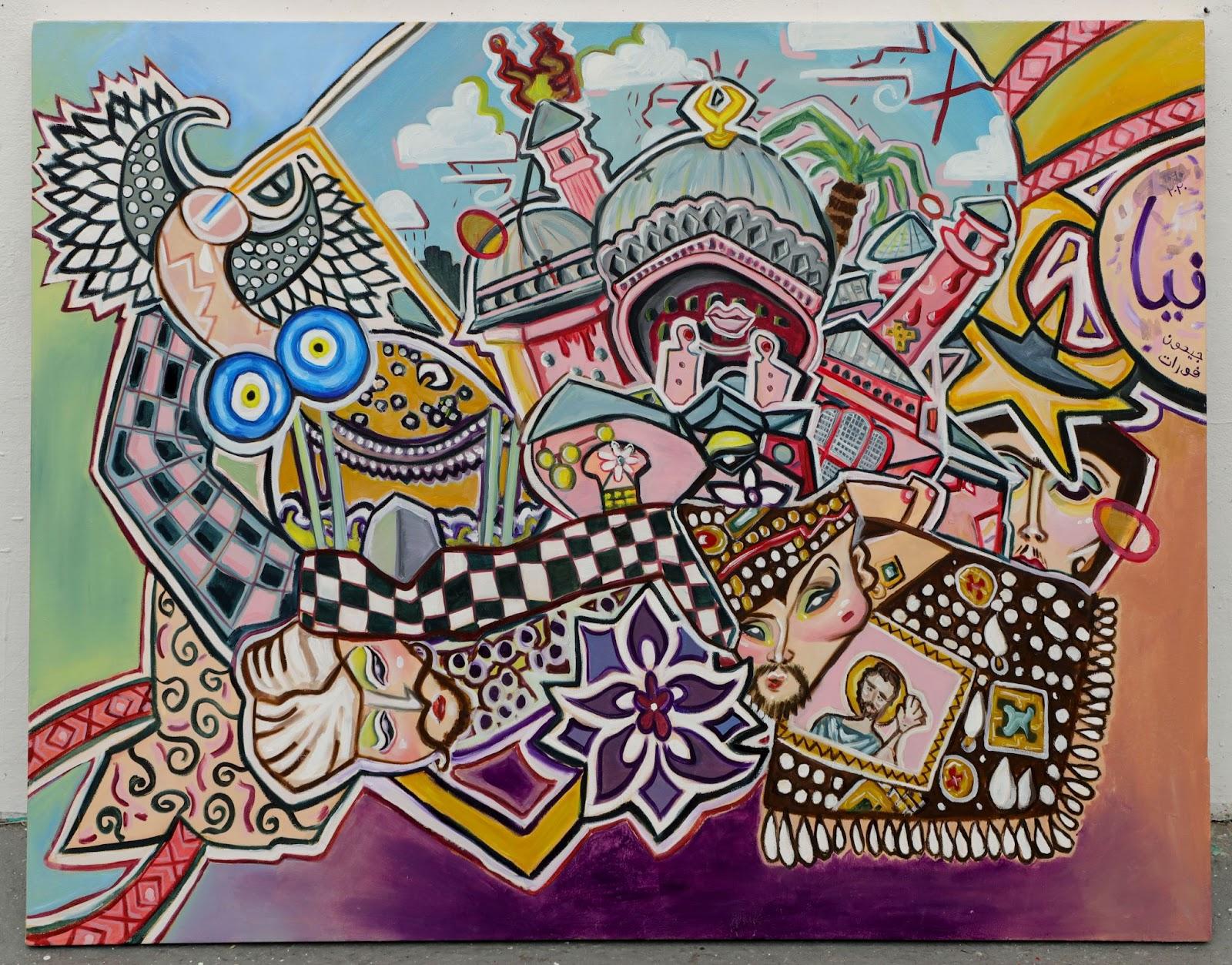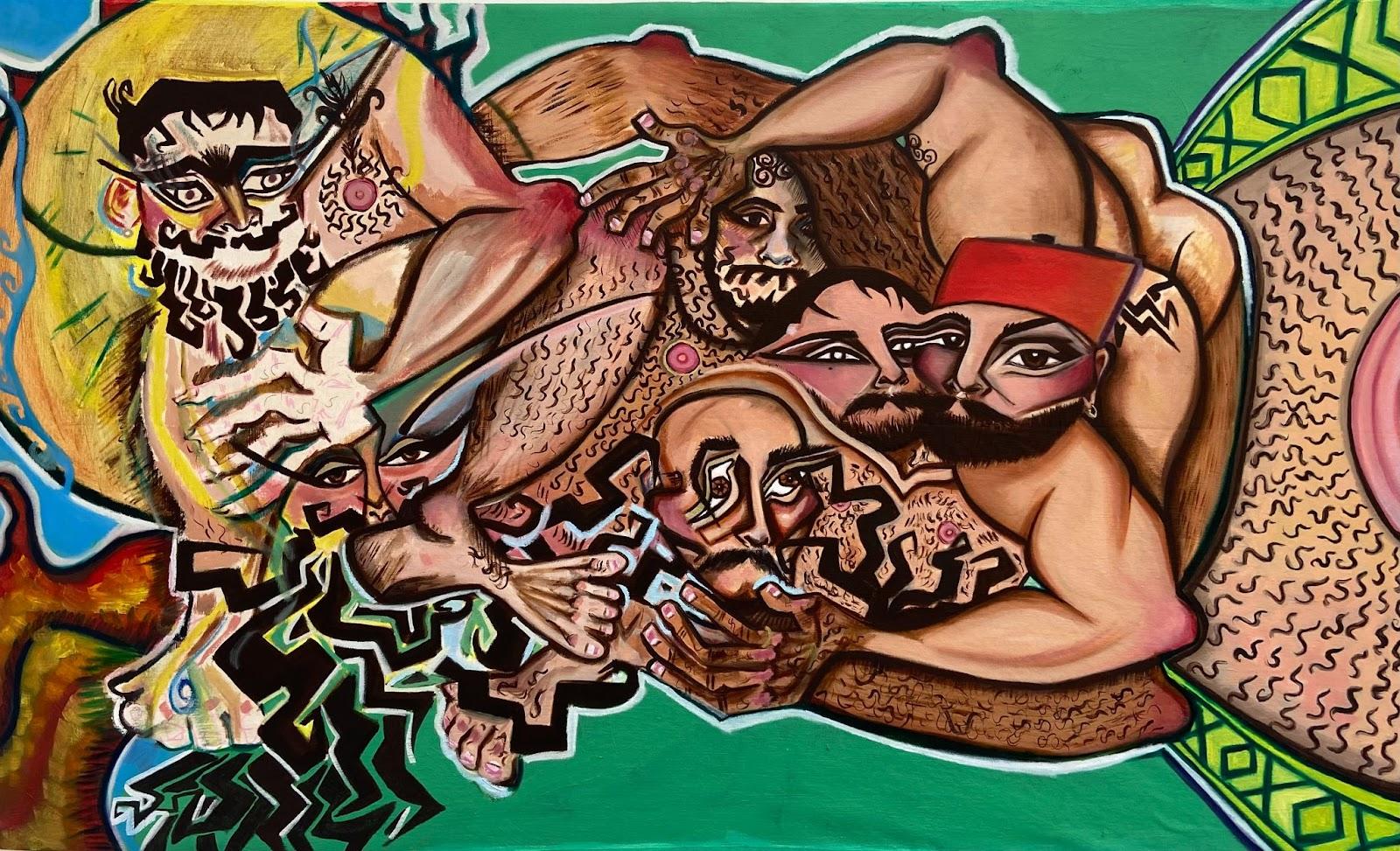A struggle of coming to terms with what Ghassan Moussawi calls fractal Orientalisms, that is, “dichotomies that pit more Western-aligned, presumably progressive, open, enlightened, or civilized spaces and cultural attitudes against those spaces and attitudes that then are framed as regressive, repressive, conservative, or uncivilized.” At least, that is one of the first things Ceyhun and I bonded over during meetings leading up to our Chat About event. Our respective moves from Lebanon and Turkey to the United States had significant impacts on our explorations of identity. Where I spent most of my time unpacking the complexities of identity and underlying feelings of displacement through my art historical research, Ceyhun did so through his paintings that, when looked at chronologically, demonstrate not only a progression of technique but also one of context as his own personal explorations evolved.
Rupturing Fractals
Maria Kuran

Speaking for myself, much of my frustrations upon arriving to the United States stemmed from being faced head-on with a society which has consistently stereotyped and undermined my culture; prior to recognizing the problematic nature of such assumptions, I succumbed to them at a younger age, fueling an anger towards my country that was deeply rooted in these fractal Orientalisms Moussawi speaks of, and that reflected in my writing early on in my academic career. This sort of anger is visually demonstrated, for instance, in a work such as Hagia Sophia,, an oil on canvas Ceyhun produced back in 2020, when the actual Hagia Sophia was set to be converted into a mosque. Recalling this moment in time, Ceyhun says:
I was thinking about the ultranationalist politics that are based on selective historical memory, violence, and to a larger extent, sexuality. In the case of this lhistorical building with its significance to Byzantine and Ottoman pasts, as well as Eastern Orthodoxy and Islam, it is very specific to contemporary Turkish politics.
Indeed, while Hagia Sophia, alludes to the shape of the church-now-mosque itself, it does not do so kindly or in accordance with what would be deemed religiously moral. Instead, it is laced with an array of quote-on-quote controversial symbols, such as the male genitalia in the middle left corner of the painting, graced with wings extending from either side of it and two evil eye symbols at its base, all while one of the structure’s towers is in flames directly behind it. Surrounding this image are other bright and outlandish figurations meant to elicit gasps and shock in the viewer, to offend.
Once upon a time, this was an interpretation of nationalism and religious extremism exclusive to Turkey, coming from a place of personal turmoil in the artist’s life, but just as technical progression takes place over the years, so do an artist’s reflections on their work from a contextual point of view. Over time, I became acutely aware of how certain perceptions I had of Lebanon were merely an extension of the microaggressions I was facing while residing in the United States. The questions thrown at me about where I came from, how I got to speaking English so well, whether I was a Muslim, or the good old-fashioned “we’re so happy you’re here” statement—each and every one of these was a mechanism of undermining my own existence and identity, of localizing the problems facing my country to avoid flipping the script onto them.
I reached a point where I began translating micro issues onto a macro scale, globalizing that which originally seemed local to my circumstances, and that is exactly what Ceyhun began to do with his art practice as well. Not only did this manifest in his paintings of recent months, but it was also expressed in his efforts to look into the past and redirect his artistic thought process. Hagia Sophia, was originally a localized observation of Turkish politics, but Ceyhun now sees it differently: “It is reflective of a larger trend across the globe: the rise of neo-nationalism everywhere and how specific sites are picked to fixate on, to reorder our reality through symbolic violence.” With this, individual experiences become intermingled with a collective body on a global scale, no longer specific or unique to any singular entity.

This is where Ceyhun stands today with his artistic process: Six-headed entangled figure, another oil on canvas, 2022, demonstrates a figuration of the collective body. What appears before the viewer is a bright composition consisting of a group of faces melded together, seemingly faces of different men or the same one repeated several times, all of which also share similarities to Ceyhun’s own facial features. It is at once a self-portrait, a portrait of no one in particular, and a portrait of everyone, a visual rendering which combines the individual with the collective, the micro with the macro, and the local with the global. As for what Ceyhun himself has to say about all this, here are his final thoughts—or at least, final for now:
I believe that in order to exist in the world today and to find meaning in our lives, we each have to repeatedly unfold and unfurl ourselves, dissect and almost tear ourselves apart in order to understand what we're made of. We then have to carefully caress and put ourselves back together again, creating a compact and harmonious whole with the greater knowledge we have gained in the process of unfolding. Only then can we enter the world as fully realized individuals, able to grasp our interconnectedness to all that is around us. The individual process parallels the societal; the micro and the macro repeat over and over again so that we hopefully learn from our past, accept our present, and imagine new futures.
Event date: May 13, 2022
Ceyhun Fırat (he/him) accumulates and arranges aesthetics and ideas that carve out a space for people who live their lives navigating seemingly contradictory spheres of influence. In his painting practice, he draws from personal and cultural histories in order to think about belonging, coherence, fragmentation, multimodality, and hyper-hybridity. He is currently an MFA candidate at the University of Chicago and as of right this second, he is writing this bio, typing things about himself in the third person, and feeling kind of weird. How very wonder-full!
Maria Kuran (she/her) is an art historian whose interests focus on issues of exile and displacement in the practices of primarily women artists of the MENA (Middle East and North Africa) region, as well as conversations surrounding institutional critique and the matter of globalization in the art world more broadly. She graduated from the MAPH program at the University of Chicago this past June; her MA thesis, “Localizing the Global: Mona Hatoum at Tate Modern and the Centre Pompidou,” utilizes Hatoum’s survey exhibition from 2015-2016 as a means of exploring the institutional politics of globalization within the confines of the Euro-American museum space. At present, Maria is working as a Research Writer with the Network for Culture & Arts Policy (NCAP) as they develop a Cultural Arts Plan for the city of Fresno, CA.